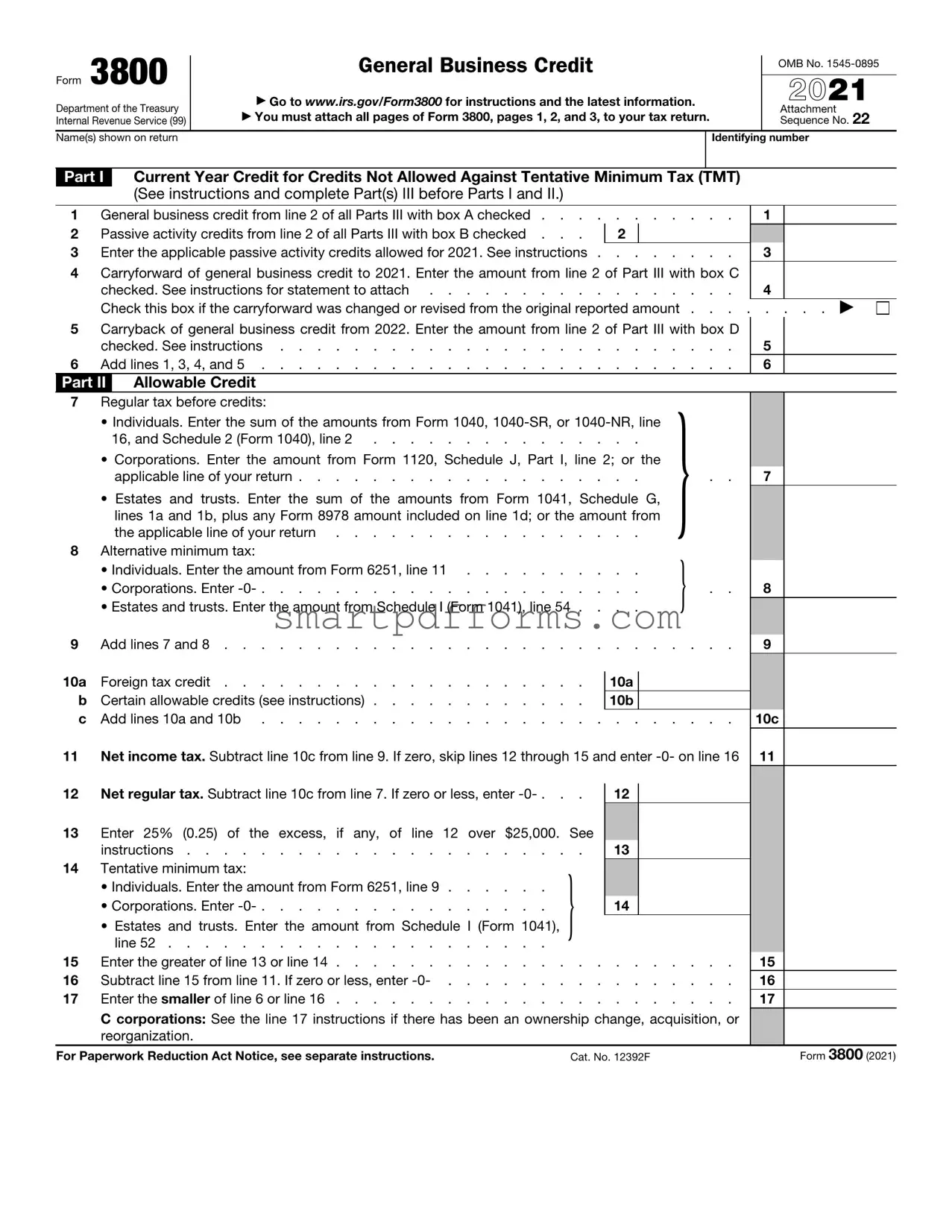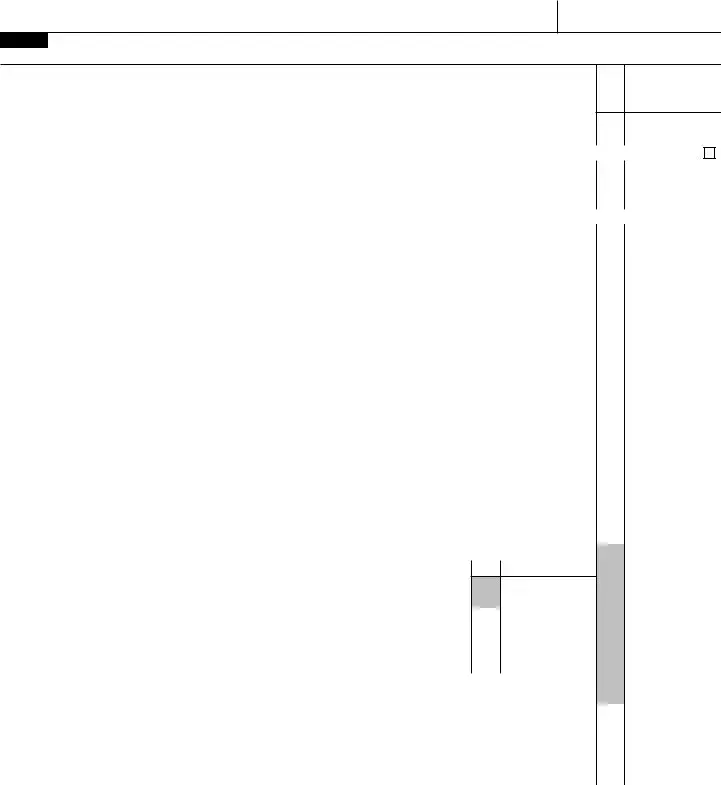Form 3800 |
General Business Credit |
|
OMB No. 1545-0895 |
|
|
|
|
|
|
|
|
|
Department of the Treasury |
▶ Go to www.irs.gov/Form3800 for instructions and the latest information. |
2021 |
▶ You must attach all pages of Form 3800, pages 1, 2, and 3, to your tax return. |
|
Attachment |
Internal Revenue Service (99) |
|
Sequence No. 22 |
Name(s) shown on return |
|
Identifying |
number |
Part I Current Year Credit for Credits Not Allowed Against Tentative Minimum Tax (TMT)
(See instructions and complete Part(s) III before Parts I and II.)
1 |
General business credit from line 2 of all Parts III with box A checked . . . . |
. . . . . . . |
1 |
|
2 |
Passive activity credits from line 2 of all Parts III with box B checked . . . |
2 |
|
|
|
3 |
Enter the applicable passive activity credits allowed for 2021. See instructions . |
. . . . . . . |
3 |
|
4Carryforward of general business credit to 2021. Enter the amount from line 2 of Part III with box C
checked. See instructions for statement to attach |
|
4 |
Check this box if the carryforward was changed or revised from the original reported amount . . . |
. . . . . ▶ |
5Carryback of general business credit from 2022. Enter the amount from line 2 of Part III with box D
|
checked. See instructions |
. . . . |
. . . . |
5 |
|
6 |
Add lines 1, 3, 4, and 5 |
. . . . |
. . . . |
6 |
|
Part II |
Allowable Credit |
|
|
|
|
|
|
|
7 |
Regular tax before credits: |
|
|
|
} |
|
|
|
|
• Individuals. Enter the sum of the amounts from Form 1040, 1040-SR, or 1040-NR, line |
|
|
|
|
|
16, and Schedule 2 (Form 1040), line 2 |
|
|
|
|
• Corporations. Enter the amount from Form 1120, Schedule J, Part I, line 2; or the |
|
|
|
|
|
applicable line of your return |
. . . |
|
. . |
7 |
|
|
• Estates and trusts. Enter the sum of the amounts from Form 1041, Schedule G, |
|
|
|
|
|
lines 1a and 1b, plus any Form 8978 amount included on line 1d; or the amount from |
|
|
|
8 |
|
the applicable line of your return |
. . . |
|
|
|
|
Alternative minimum tax: |
|
|
|
} |
|
|
|
|
• Individuals. Enter the amount from Form 6251, line 11 |
|
|
|
|
• Corporations. Enter -0- |
. . . |
|
. . |
8 |
|
|
• Estates and trusts. Enter the amount from Schedule I (Form 1041), line 54 . |
. . . |
|
|
|
|
|
|
|
|
|
|
|
|
9 |
Add lines 7 and 8 |
. . . . |
. . . . |
9 |
|
|
|
|
|
|
|
|
|
10a |
Foreign tax credit |
|
10a |
|
|
|
|
|
b |
Certain allowable credits (see instructions) |
|
10b |
|
|
|
|
|
c |
Add lines 10a and 10b |
. . . . |
. . . . |
10c |
11 |
Net income tax. Subtract line 10c from line 9. If zero, skip lines 12 through 15 and enter -0- on line 16 |
11 |
|
12 |
Net regular tax. Subtract line 10c from line 7. If zero or less, enter -0- . . . |
12 |
|
|
|
|
|
13Enter 25% (0.25) of the excess, if any, of line 12 over $25,000. See
|
instructions |
. |
13 |
|
|
|
|
14 |
Tentative minimum tax: |
} |
|
|
|
|
|
|
• Individuals. Enter the amount from Form 6251, line 9 |
|
|
|
|
|
|
• Corporations. Enter -0- |
14 |
|
|
|
|
|
• Estates and trusts. Enter the amount from Schedule I (Form 1041), |
|
|
|
|
|
|
line 52 |
|
|
|
|
|
|
15 |
Enter the greater of line 13 or line 14 |
. . . . . . . . . |
|
15 |
|
16 |
Subtract line 15 from line 11. If zero or less, enter -0- |
. . . . . . . . . |
|
16 |
|
17 |
Enter the smaller of line 6 or line 16 |
. . . . . . . . . |
|
17 |
|
|
C corporations: See the line 17 instructions if there has been an ownership change, acquisition, or |
|
|
|
reorganization. |
|
|
|
|
|
|
For Paperwork Reduction Act Notice, see separate instructions. |
Cat. No. 12392F |
|
Form 3800 (2021) |
Part II Allowable Credit (continued)
Note: If you are not required to report any amounts on line 22 or 24 below, skip lines 18 through 25 and enter -0- on line 26.
18 |
Multiply line 14 by 75% (0.75). See instructions |
. . . . . . . . |
18 |
|
19 |
Enter the greater of line 13 or line 18 |
. . . . . . . . |
19 |
|
20 |
Subtract line 19 from line 11. If zero or less, enter -0- |
. . . . . . . . |
20 |
|
21 |
Subtract line 17 from line 20. If zero or less, enter -0- |
. . . . . . . . |
21 |
|
22 |
Combine the amounts from line 3 of all Parts III with box A, C, or D checked . |
. . . . . . . . |
22 |
|
23 |
Passive activity credit from line 3 of all Parts III with box B checked . . . |
|
23 |
|
|
|
|
|
|
|
24 |
Enter the applicable passive activity credit allowed for 2021. See instructions |
. . . . . . . . |
24 |
|
25 |
Add lines 22 and 24 |
. . . . . . . . |
25 |
|
26Empowerment zone and renewal community employment credit allowed. Enter the smaller of line 21
|
or line 25 |
. . . . . . . |
26 |
|
27 |
Subtract line 13 from line 11. If zero or less, enter -0- |
. . . . . . . |
27 |
|
28 |
Add lines 17 and 26 |
. . . . . . . |
28 |
|
29 |
Subtract line 28 from line 27. If zero or less, enter -0- |
. . . . . . . |
29 |
|
30 |
Enter the general business credit from line 5 of all Parts III with box A checked . |
. . . . . . . |
30 |
|
31 |
Reserved |
. . . . . . . |
31 |
|
|
32 |
Passive activity credits from line 5 of all Parts III with box B checked . . . |
|
32 |
|
|
|
|
|
|
|
33 |
Enter the applicable passive activity credits allowed for 2021. See instructions . |
. . . . . . . |
33 |
|
34Carryforward of business credit to 2021. Enter the amount from line 5 of Part III with box C checked
and line 6 of Part III with box G checked. See instructions for statement to attach |
|
34 |
Check this box if the carryforward was changed or revised from the original reported amount . . . |
. . . . . ▶ |
35Carryback of business credit from 2022. Enter the amount from line 5 of Part III with box D checked.
|
See instructions |
. . |
35 |
|
36 |
Add lines 30, 33, 34, and 35 |
. . |
36 |
|
37 |
Enter the smaller of line 29 or line 36 |
. . |
37 |
|
38 |
Credit allowed for the current year. Add lines 28 and 37. |
|
|
|
|
|
Report the amount from line 38 (if smaller than the sum of Part I, line 6, and Part II, lines 25 and 36, |
|
|
|
see instructions) as indicated below or on the applicable line of your return. |
} |
|
|
|
|
• Individuals. Schedule 3 (Form 1040), line 6 |
|
|
|
|
• Corporations. Form 1120, Schedule J, Part I, line 5c |
. . |
|
|
|
• Estates and trusts. Form 1041, Schedule G, line 2b |
|
38 |
|
Form 3800 (2021)
Name(s) shown on return
Part III General Business Credits or Eligible Small Business Credits (see instructions)
Complete a separate Part III for each box checked below. See instructions.
A |
General Business Credit From a Non-Passive Activity |
E |
|
Reserved |
|
B |
General Business Credit From a Passive Activity |
F |
|
Reserved |
|
C |
General Business Credit Carryforwards |
G |
|
Eligible Small Business Credit Carryforwards |
D |
General Business Credit Carrybacks |
H |
|
Reserved |
|
IIf you are filing more than one Part III with box A or B checked, complete and attach first an additional Part III combining amounts from
all Parts III with box A or B checked. Check here if this is the consolidated Part III . . . . . . . . . . . . . . . . ▶
|
(a) Description of credit |
|
(b) Enter EIN if |
(c) Enter the |
Note: On any line where the credit is from more than one source, a separate Part III is needed for each |
|
claiming the credit |
appropriate |
|
from a pass-through |
amount. |
pass-through entity. |
|
|
entity. |
|
1a |
Investment (Form 3468, Part II only) (attach Form 3468) |
1a |
|
b |
Reserved |
1b |
|
|
c |
Increasing research activities (Form 6765) |
1c |
|
d |
Low-income housing (carryforward only) (see instructions) |
1d |
|
e |
Disabled access (Form 8826)* |
1e |
|
f |
Renewable electricity, refined coal, and Indian coal production (Form 8835) . . |
1f |
|
g |
Indian employment (Form 8845) |
1g |
|
h |
Orphan drug (Form 8820) |
1h |
|
i |
New markets (Form 8874) |
1i |
|
j |
Small employer pension plan startup costs and auto-enrollment (Form 8881) . . |
1j |
|
k |
Employer-provided child care facilities and services (Form 8882)* |
1k |
|
l |
Biodiesel and renewable diesel fuels (attach Form 8864) |
1l |
|
m |
Low sulfur diesel fuel production (Form 8896) |
1m |
|
n |
Distilled spirits (Form 8906) |
1n |
|
o |
Nonconventional source fuel (carryforward only) |
1o |
|
p |
Energy efficient home (Form 8908) |
1p |
|
q |
Energy efficient appliance (carryforward only) |
1q |
|
r |
Alternative motor vehicle (Form 8910) |
1r |
|
s |
Alternative fuel vehicle refueling property (Form 8911) |
1s |
|
t |
Enhanced oil recovery credit |
1t |
|
u |
Mine rescue team training (Form 8923) |
1u |
|
v |
Agricultural chemicals security (carryforward only) |
1v |
|
w |
Employer differential wage payments (Form 8932) |
1w |
|
x |
Carbon oxide sequestration (Form 8933) |
1x |
|
y |
Qualified plug-in electric drive motor vehicle (Form 8936) |
1y |
|
z |
Qualified plug-in electric vehicle (carryforward only) |
1z |
|
aa |
Employee retention (Form 5884-A) |
1aa |
|
bb |
General credits from an electing large partnership (carryforward only) . . . . |
1bb |
|
zzOther. Oil and gas production from marginal wells (Form 8904) and certain other
|
credits (see instructions) |
1zz |
2 |
Add lines 1a through 1zz and enter here and on the applicable line of Part I . . |
2 |
|
|
3 |
Enter the amount from Form 8844 here and on the applicable line of Part II . . |
3 |
|
|
4a |
Investment (Form 3468, Part III) (attach Form 3468) |
4a |
b |
Work opportunity (Form 5884) |
4b |
c |
Biofuel producer (Form 6478) |
4c |
d |
Low-income housing (Form 8586) |
4d |
e |
Renewable electricity, refined coal, and Indian coal production (Form 8835) . . |
4e |
f |
Employer social security and Medicare taxes paid on certain employee tips (Form 8846) |
4f |
g |
Qualified railroad track maintenance (Form 8900) |
4g |
h |
Small employer health insurance premiums (Form 8941) |
4h |
i |
Increasing research activities (Form 6765) |
4i |
j |
Employer credit for paid family and medical leave (Form 8994) |
4j |
z |
Other |
4z |
5 |
Add lines 4a through 4z and enter here and on the applicable line of Part II . . |
5 |
|
|
6 |
Add lines 2, 3, and 5 and enter here and on the applicable line of Part II . . . |
6 |
|
|
* See instructions for limitation on this credit. |
|
|
Form 3800 (2021) |



